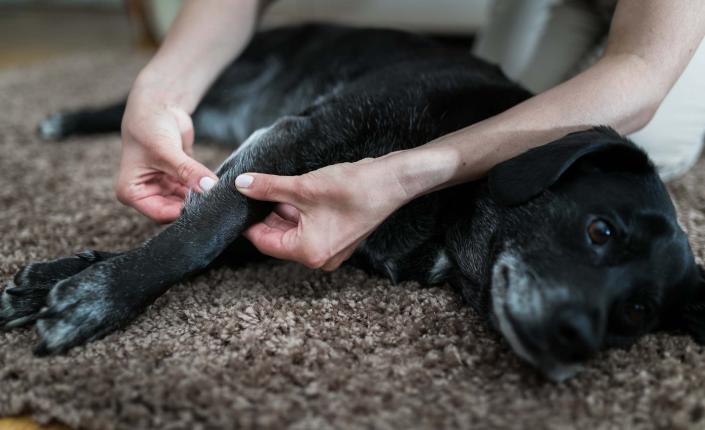Understanding Osteoarthritis in Dogs and Cats

Osteoarthritis (OA) is a degenerative joint illness that commonly affects both dogs and cats. While the degenerative process can start early, the signs of OA become more apparent with age. This condition results from the gradual breakdown of cartilage—the cushiony tissue at the ends of bones that allows for smooth joint movement. As the cartilage is damaged or worn away, there is increased friction and inflammation within the joint. Bones may even rub against each other, leading to pain, swelling, and decreased mobility. While OA is more frequently recognized in dogs, it's increasingly diagnosed in cats as veterinarians and pet parents become more aware of its subtle signs in feline patients.
What Causes Osteoarthritis?
Osteoarthritis develops due to a combination of factors, including age, genetics, conformation (the shape and engineering of the joint), injuries, repetitive strain, and obesity. In dogs, large breeds like Labrador Retrievers, German Shepherds, and Golden Retrievers are more prone to OA, particularly if they are overweight or have conformational abnormalities of the joints, such as hip dysplasia. For cats, OA can be seen in any breed but is more common in older, overweight, or large breed cats. Unlike dogs, cats are adept at hiding their discomfort, which often leads to a delayed diagnosis.
What Does Osteoarthritis Look Like?
The clinical signs of osteoarthritis can vary between dogs and cats:
- Dogs: Common symptoms include limping or other gait changes, stiffness (especially after rest), difficulty getting up, reluctance to exercise, hesitation around stairs, and behavioral changes like irritability due to pain. You might also notice muscle atrophy in the affected limb due to decreased usage.
- Cats: Symptoms in cats can be more subtle. Owners might observe reduced activity levels, hesitation to jump or climb, decreased grooming, litter box accidents, or changes in temperament, such as increased aggression, decreased social interaction, or hiding.
How is Arthritis Diagnosed?
Diagnosing OA involves a combination of clinical examination and diagnostic imaging. Veterinarians will assess your pet's range of motion, gait, joint pain, and any visible signs of discomfort. X-rays are commonly used to confirm the diagnosis by revealing joint changes like bone spurs, fluid accumulation, or cartilage loss. In some cases, more advanced imaging techniques like MRI or CT scans may be used, especially if the condition is complex or involves multiple joints.
How Can Osteoarthritis be Treated?
1. Medical Management
- Non-Steroidal Anti-Inflammatory Drugs (NSAIDs): NSAIDs are frequently prescribed to manage pain and inflammation. While dogs have several NSAID options approved for long-term use, cats have fewer safe choices due to their sensitivity to these medications. Long-term NSAID use, especially in cats, should be closely monitored by a veterinarian to avoid potential side effects like kidney damage.
- Monoclonal Antibody Therapy: Newer therapies, like Librela (for dogs) and Solensia (for cats), involve monoclonal antibodies that target and neutralize nerve growth factor, an important mediator in signalling pain. These injections have been shown to reduce OA pain without the side effects commonly seen with NSAIDs.
- Supplements: Joint supplements containing glucosamine HCl, chondroitin sulfate, and omega-3 fatty acids may help improve joint health and reduce inflammation. While these are not a cure, they can be a beneficial part of a comprehensive treatment plan.
2. Physical Therapy and Alternative Treatments
- Physical Rehabilitation: Techniques like hydrotherapy, massage, and controlled exercises can improve joint mobility and muscle strength. Physical therapy is especially useful for dogs but can also benefit cats if they tolerate handling.
- Acupuncture: This alternative therapy can help alleviate pain and improve quality of life, particularly in older pets who cannot tolerate traditional medications.
- Laser Therapy: Low-level laser therapy is another non-invasive option that can reduce pain and inflammation in affected joints
3. Weight Management and Lifestyle Adjustments
Maintaining an ideal body weight is a critical part of managing OA. Excess weight puts additional stress on joints, exacerbating pain, stiffness, and wear and tear. Implementing a balanced diet and engaging in low-impact activities, like short walks or gentle play sessions, can significantly benefit pets with OA.
In addition to weight management, making environmental adjustments can enhance your pet's comfort and independence. For dogs, using orthopedic beds and non-slip rugs can reduce the strain on joints and improve mobility. For cats, consider adding ramps or pet stairs to help them access favorite resting spots without jumping. Additionally, make sure that all essential resources, like food and water bowls, bedding, litter boxes, and hiding areas, are all located in accessible and comfortable areas of the home.
4. Surgical Management
In cases where joint instability or joint incongruity (poorly aligned bones) are responsible for the development of OA, surgical options may be available to improve the function of the joint. While surgery cannot eliminate or reverse OA, it may reduce the future severity of the issue, and provide more comfortable and functional mobility.
At-Home Care Tips
- Comfortable Bedding: Provide soft, supportive bedding to alleviate pressure on joints.
- Temperature Control: Cold weather can worsen joint pain, so keep your pet warm with blankets or gently heated beds.
- Joint-Friendly Environment: Reduce the need for jumping or climbing by placing ramps near furniture and using raised food and water bowls.
- Consistent Exercise: Engage in low-impact exercises like gentle walks or interactive play with cats to maintain muscle tone without overburdening the joints.
By understanding the signs of osteoarthritis and seeking prompt veterinary care, you can help your furry companion enjoy a happier, healthier life even with this common condition.
Prognosis
While osteoarthritis is a chronic and progressive condition, many dogs and cats can live comfortable and fulfilling lives with proper management. Early detection and a comprehensive treatment plan tailored to your pet's needs can help slow disease progression and improve quality of life. Regular veterinary check-ups, along with adjustments to medications, nutrition, and other therapies, ensure that your pet remains as pain-free and independent as possible.